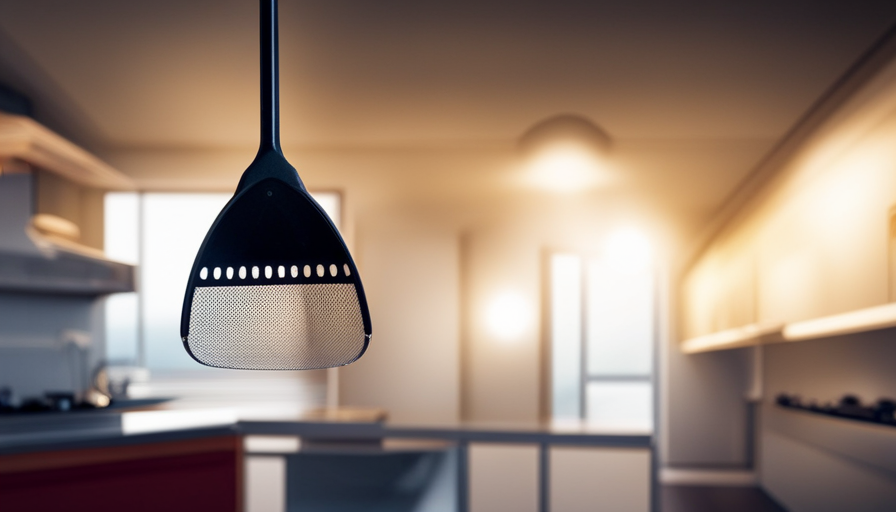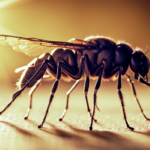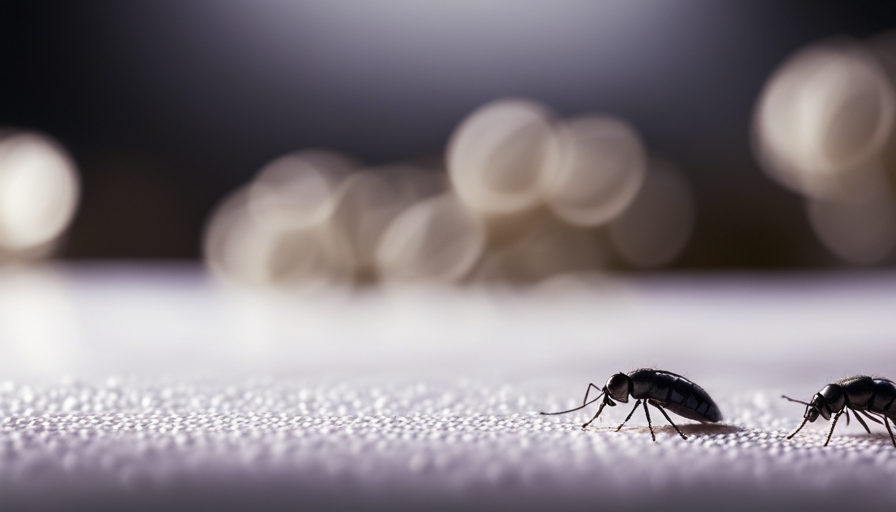Tired of pesky little bugs buzzing around your home? Don’t worry, I’m here to help you eliminate those tiny house flies once and for all. Even though they may seem small, these insects can become a major nuisance if not taken care of quickly.
In this article, I will share with you my expert knowledge on how to:
- Identify the source of the infestation
- Keep your home clean and tidy
- Remove potential food sources
- Seal cracks and openings
- Use fly traps or sticky fly paper
- Utilize essential oils as natural repellents
- Clean and empty trash bins regularly
- Store fruits and vegetables properly
- Know when to consult a pest control professional if needed.
By following these simple yet effective steps, you can reclaim your home from these bothersome house flies and enjoy a fly-free environment. So, let’s get started on our mission to bid farewell to those tiny pests!
Key Takeaways
- Identify and eliminate the source of house flies, such as decaying organic matter and food waste.
- Keep your home clean and tidy to prevent fly infestations.
- Properly store fruits and vegetables to reduce fly attractiveness.
- Utilize DIY traps, essential oils, and professional pest control services for effective fly removal.
Identify the Source of the Infestation
To get rid of those pesky little house flies, start by identifying the source of the infestation. These tiny insects can be quite a nuisance, and it’s important to take swift action to prevent future infestations.
One of the key steps in eliminating house flies is to ensure proper waste disposal. House flies are attracted to decaying organic matter, such as food waste and animal feces. By taking the time to properly dispose of these materials, you can significantly reduce the likelihood of a fly infestation.
Begin by inspecting your home for any areas where flies may be breeding. This could include garbage cans, compost bins, or even pet waste areas. Make sure that all garbage cans have tight-fitting lids and are emptied regularly. Additionally, keep your compost bin covered and away from the main living areas. When it comes to pet waste, be diligent about cleaning up after your pets and disposing of it in a sealed bag.
By addressing the source of the infestation and implementing proper waste disposal practices, you can greatly reduce the presence of house flies in your home. Keep your home clean and tidy, and remember to regularly dispose of waste to maintain a fly-free environment.
Keep Your Home Clean and Tidy
Maintaining a clean and organized home will help you create an environment that’s less appealing to those pesky little creatures buzzing around. Flies are attracted to food and organic matter, so it’s important to keep your home clean and tidy to prevent their infestation.
Regularly cleaning your kitchen countertops, floors, and surfaces will eliminate any food residue that may attract flies. Be sure to also clean up spills immediately and store food in sealed containers to minimize their access to potential food sources.
Additionally, emptying your trash regularly and keeping it sealed will prevent flies from being attracted to the odor. Organizing strategies, such as decluttering and properly storing items, will reduce hiding places for flies and make it easier to clean your home effectively.
By following these cleaning tips and organizing strategies, you can create an environment that’s less appealing to flies and discourage their presence in your home. With a clean and organized home, you can take the next step in removing potential food sources and further reducing the chances of a fly infestation.
Remove Potential Food Sources
Take control of your home by eliminating any potential food sources that may attract those annoying little creatures. Flies are attracted to any type of food, and even the tiniest crumbs can be enticing to them. To ensure that your home remains fly-free, it is important to eliminate garbage promptly and maintain cleanliness in your kitchen and dining areas. Here are some simple steps you can take to remove potential food sources:
| Food Sources to Eliminate | Alternative Solutions |
|---|---|
| Exposed fruits and vegetables | Store them in sealed containers or in the refrigerator |
| Dirty dishes and food spills | Clean up spills immediately and wash dishes promptly |
| Open garbage cans | Use tightly sealed garbage containers and dispose of garbage regularly |
| Pet food left out | Feed your pets at specific times and remove any uneaten food |
By eliminating these food sources, you are reducing the attractiveness of your home to flies. Maintaining cleanliness and proper hygiene will discourage them from entering your space. Now that you have removed their potential food sources, the next step is to seal cracks and openings in your home to prevent the flies from finding their way inside.
Seal Cracks and Openings
Ensure your home is a fortress against those pesky little flyers by sealing cracks and openings that could be their secret entrance. Tiny house flies have a knack for finding the tiniest gaps in windows, doors, or even walls.
To effectively seal these entry points, you have a few sealant options at your disposal. Silicone caulk is an excellent choice due to its durability and flexibility. It can be applied to gaps as small as 1/8 inch wide, ensuring a tight seal. Another option is expanding foam sealant, which expands to fill larger gaps and offers excellent insulation properties.
When applying sealant, it’s crucial to be thorough and precise. Start by inspecting your home for any cracks or openings that could serve as an inviting invitation for house flies. Pay close attention to areas around windows, doors, utility openings, and vents. Once you identify these vulnerable spots, use the appropriate sealant to create a barrier that will prevent the flies from sneaking in.
Sealing cracks and openings is just one of the many pest prevention measures you can take. In the subsequent section, we will explore another effective method: using fly traps or sticky fly paper. These traps can be strategically placed around your home to catch and eliminate any flies that manage to find their way inside.
Use Fly Traps or Sticky Fly Paper
One effective method for keeping pesky house flies at bay is by using fly traps or sticky fly paper. These traps are designed to attract and trap flies, preventing them from buzzing around your home. Fly traps work by emitting a scent or using a light source to lure flies into a sticky surface, where they become trapped and unable to escape. Sticky fly paper, on the other hand, is coated with a sticky substance that flies get stuck to when they land on it. Both of these methods can be highly effective in reducing the number of flies in your home.
To give you a visual representation of the effectiveness of fly traps and sticky fly paper, I have created a table below:
| Pros | Cons |
|---|---|
| Easy to use | May not catch all flies |
| Environmentally friendly | |
| No chemicals required | |
| Can be placed anywhere | |
In addition to using fly traps and sticky fly paper, you can also consider using a fly swatter or insecticide spray to directly target and eliminate flies. These methods can be particularly useful for getting rid of individual flies that are already inside your home. By combining these different strategies, you can create a comprehensive approach to dealing with house flies.
Now, let’s move on to the next section, where we will discuss how to make a DIY fruit fly trap.
Make a DIY Fruit Fly Trap
To continue our discussion on getting rid of tiny house flies, let’s delve into the topic of making a DIY fruit fly trap. This method is effective and easy to set up, requiring just a few common household items.
One option is using a vinegar trap. Fruit flies are attracted to the smell of vinegar, making it an ideal bait for them. Simply fill a small container with apple cider vinegar, cover it with plastic wrap, and poke a few small holes in the top. The flies will be lured in by the scent and become trapped inside the container.
Another effective trap involves using dish soap. Fill a jar with a mixture of water and a few drops of dish soap. The soap reduces the surface tension of the water, causing the flies to sink and drown when they come into contact with the liquid.
Now, let’s explore the benefits of these DIY traps. They’re cost-effective, environmentally friendly, and safe to use around children and pets. Furthermore, they provide a targeted approach to eliminating fruit flies without the use of harmful chemicals.
Transitioning into our next section, we’ll discuss how to use essential oils as natural repellents.
Use Essential Oils as Natural Repellents
Using essential oils as natural repellents is a great way to keep those pesky little flies away from your home. Not only do essential oils have many benefits in household cleaning, but they can also be effective in pest control.
Different types of essential oils have varying uses in repelling flies and other insects. For example, peppermint oil has a strong scent that flies find repulsive, making it a great option for keeping them at bay. Citronella oil is another powerful repellent that can be used both indoors and outdoors. Its strong fragrance masks the scents that attract flies, making it an effective deterrent. Eucalyptus oil is known for its antiseptic properties and can help repel flies while also freshening up your home.
By incorporating these essential oils into your cleaning routine, you can not only keep your home clean but also get rid of those annoying flies. So, remember to clean and empty your trash bins regularly to prevent flies from being attracted to them.
Clean and Empty Trash Bins Regularly
Make sure you regularly clean and empty your trash bins to keep your home free from the annoyance of flies buzzing around. Flies are attracted to decaying organic matter, and your trash bins are a prime breeding ground for them.
By maintaining a regular cleaning routine and proper waste disposal, you can effectively eliminate these pesky insects from your living space. To start, it’s important to clean your trash bins thoroughly. Remove any remaining garbage and rinse them with hot, soapy water. Use a scrub brush to scrub away any residue or debris that may have accumulated on the sides or bottom of the bins. This will help remove any food particles or odors that may attract flies.
After cleaning, make sure to dry the bins completely before placing new garbage inside. Moisture can attract flies, so it’s essential to keep the bins dry and free from any lingering smells.
In addition to regular cleaning, it’s crucial to empty your trash bins regularly. Dispose of the garbage in sealed bags and place them in outdoor bins away from your home. This will prevent flies from being attracted to the waste and entering your living area.
By incorporating a proper cleaning routine and regular waste disposal, you can effectively eliminate flies from your home. Keep fruits and vegetables stored properly, as their rotting can also attract flies, as discussed in the subsequent section.
Keep Fruits and Vegetables Stored Properly
Ensure your fruits and vegetables are stored properly, so you can savor their freshness and keep those pesky flies at bay. Proper storage is essential to prevent infestation and maintain the quality of your produce.
When it comes to fruits, make sure to separate them from vegetables as they emit different gases that can accelerate ripening and spoilage. Keep fruits in a cool, dry place away from direct sunlight. Some fruits like apples and bananas release ethylene gas, so store them separately to avoid premature spoilage of other produce.
For vegetables, it’s crucial to store them in the refrigerator’s crisper drawer. This compartment provides the ideal humidity and temperature levels to prolong their freshness. However, avoid overcrowding the drawer, as it restricts air circulation and can lead to premature decay. Additionally, ensure that vegetables are free from any dirt or moisture before storing, as this can attract flies and other pests.
By following these proper storage practices, you can effectively prevent infestation and enjoy your fruits and vegetables for a longer period. However, if the problem persists despite your efforts, it may be necessary to consult a pest control professional who can provide you with further guidance and assistance.
Consult a Pest Control Professional if Needed
If the pesky little critters persist despite all your efforts, it might be time to call in the experts – a pest control professional can work wonders in banishing those annoying house flies! Hiring a professional pest control service can provide you with the expertise and resources needed to effectively eliminate these tiny pests from your home.
Here are four reasons why hiring a professional is the best option:
-
Expertise: Pest control professionals are trained in identifying the specific type of flies infesting your home and implementing targeted solutions to eradicate them. They have extensive knowledge of the behavior and habits of house flies, allowing them to devise effective strategies.
-
Advanced Techniques: Professionals use state-of-the-art equipment and advanced techniques to eliminate house flies. They have access to specialized treatments that aren’t available to the general public, ensuring a more thorough and long-lasting solution.
-
Safety Measures: Pest control professionals are well-versed in the safe handling and application of pesticides. They know how to use these chemicals in a way that minimizes risks to you, your family, and the environment.
-
Preventive Measures: In addition to eliminating existing house flies, professionals can also provide recommendations and implement preventive measures to ensure they don’t return in the future. This may include sealing entry points, improving sanitation, and implementing fly control devices.
When all else fails, hiring a professional pest control service is the most effective way to get rid of tiny house flies. Their expertise, advanced techniques, safety measures, and preventive strategies make them the ideal choice for eradicating these annoying pests from your home.
Frequently Asked Questions
How do I identify the species of tiny house flies causing the infestation?
To identify the species of tiny house flies causing the infestation, carefully observe their physical characteristics such as body color, wing pattern, and size. Consulting a professional entomologist or using a magnifying lens can help in accurate identification.
Can I use vinegar or bleach to clean and disinfect surfaces to prevent house flies?
To prevent house flies, vinegar can be used to clean and disinfect surfaces. It is a natural remedy that is effective due to its acidic properties. Bleach, on the other hand, may not be as effective in repelling house flies.
Are there any specific types of food that I should avoid leaving out to prevent attracting house flies?
To prevent attracting house flies, avoid leaving out food such as fruits, vegetables, and meat. Additionally, natural remedies like essential oils, fly traps, or fly screens can help repel house flies.
Should I seal cracks and openings both indoors and outdoors to effectively prevent house flies?
Sealing cracks and openings indoors and outdoors is essential for preventing house flies. It helps create a barrier that keeps them out of your living space.
Are there any specific essential oils that are known to be more effective in repelling house flies?
The most effective essential oils for repelling house flies include peppermint, lavender, and eucalyptus. Using natural remedies for fly control has numerous benefits, such as avoiding the use of chemicals and promoting a healthier environment.
Conclusion
In conclusion, getting rid of tiny house flies requires a proactive approach and a keen attention to detail. By identifying the source of the infestation and keeping our homes clean and tidy, we can effectively eliminate these pesky insects from our living spaces.
Removing potential food sources, sealing cracks and openings, and using fly traps or sticky fly paper are also important steps in getting rid of tiny house flies. Additionally, using essential oils as natural repellents, cleaning and emptying trash bins regularly, and storing fruits and vegetables properly can help prevent and eliminate these flies.
Remember, "An ounce of prevention is worth a pound of cure."
Hi, I’m Emma. I’m the Editor in Chief of Tiny House 43, a blog all about tiny houses. While tree houses are often associated with childhood, they can be the perfect adult retreat. They offer a cozy space to relax and unwind, surrounded by nature. And since they’re typically built on stilts or raised platforms, they offer stunning views that traditional homes simply can’t match. If you’re looking for a unique and romantic getaway, a tree house tiny house might just be the perfect option.
















